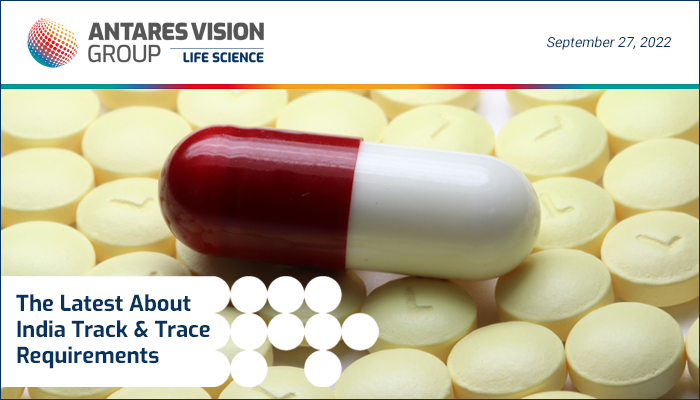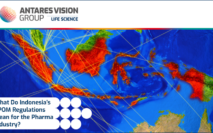It’s been a busy year with India track and trace requirements. The Ministry of Health has extended a deadline, announced a new deadline, and released new draft rules concerning key areas of the country’s pharmaceutical regulations.
There are deadlines coming up in the next 6 months, so let’s take a look at what’s happening with these India track and trace requirements..
India track and trace requirements for 2023
The upcoming India track and trace requirements affect three areas of manufacturing: labeling active pharmaceutical ingredients (APIs), reporting, and product labeling for the Top 300 brands. We’ll go in chronological order:
Labeling APIs: January 2023 deadline
Starting January 1, 2023, all imported and domestically manufactured APIs must be labeled with QR codes “at each level packaging that store data or information.” The government says this will help combat falsified drugs.
This is the culmination of a process that began in June 2019, when the Drugs Technical Advisory Board (DTAB) approved a proposal mandating QR codes on APIs. At that time, DTAB estimated that the regulation would affect approximately 2,500 APIs.
The QR codes must contain 11 data points:
- Unique product identification code
- Name of the API
- Brand name (if any)
- Name and address of the manufacturer
- Batch number
- Batch size
- Date of manufacturing
- Date of expiry or retesting
- Serial shipping container code
- Manufacturing license number or import license number
- Special storage conditions required (if any)
QR codes will also link to a national database with pricing data from the National Pharmaceutical Pricing Authority.
Companies are required to get a GS1 Company Prefix, a unique number that identifies a company as the owner a barcode and the product to which it’s affixed, and a GS1 Global Location Number. GS1 Global Trade Item Numbers will serve as the “unique identification code.”
Reporting to the iVEDA Portal: March 2023 deadline
On April 4, 2022, the Directorate General of Foreign Trade (DGFT) released a public notice that extended to March 31, 2023, the deadline for export reporting to the Integrated Validation of Exports of Drugs from India and its Authentication (iVEDA) portal. The change applies to both small-scale industry (SSI)- and non-SSI-manufactured drugs.
The deadline for this requirement has been postponed at least four times, starting in 2018, when India track and trace requirements centered around another reporting portal, the Drugs Authentication and Verification Application (DAVA). As we reported when iVEDA was launched, the deadline was changed from April 1, 2020, to October 1, 2020. It was changed again in April 2021 and, as we’re discussing now, in April 2022.
Draft regulations for barcoding pharma products: May 2023 deadline
On September 5, the Ministry of Health and Family Welfare published draft guidelines for barcoding the Top 300 brands in the country, all of which are named in “Schedule H2” of the announcement. The rules will come into force on May 1, 2023.
The goal of these India track and trace requirements — like so many other regulations around the world — is to combat counterfeiting, diversion, and unauthorized sales. The rules stipulate that eight data points must be incorporated into a “Bar Code or Quick Response Code” to be printed on or affixed to the primary packaging:
- Unique product identification code (e.g., GTIN)
- Proper and generic drug name
- Brand name
- Batch number
- Expire date
- Manufacturer name and address
- Manufacture date
- Manufacturing license number
If there is “inadequate space in primary package label,” the codes must be placed on the secondary packaging.
Industry observers have noted concerns with the guidelines, including:
- QR codes may not be practical for data-dense pharmaceutical labeling.
- The guidelines may not actually help fight counterfeits, diversion, and unauthorized sales.
- In order for the eight mandated data points to be readable, labels would have to be unrealistically large — too big to fit on most packages.
- It’s not clear if 2D DataMatrix codes would meet the requirements for a “Bar Code” in the guidelines.
- GS1 standards are not required; in fact, they’re not mentioned at all.
To this last point, the initial response seems to point toward a call for GS1 standards: DataMatrix for barcoding, GTINs to identify products, use of two-digit Authentication Identifiers.
Final thoughts
India track and trace requirements are obviously evolving. Expect more changes as the deadlines for APIs, iVEDA reporting, and barcoding get nearer.
But one thing won’t change: India will continue to cultivate its position in the global pharmaceutical industry. Consider these statistics from its Department of Pharmaceuticals 2020-21 Annual Report:
- The Indian pharmaceutical industry is the world’s third largest by volume and 14th largest in terms of value.
- It has the second-most FDA-approved plants for generic drug manufacturing outside the United States.
- It accounts for 60% of global vaccine production.
- It is the world’s third-largest API market (8% share of global API industry, 500+ APIs manufactured in India, and it contributes 57% of APIs on the World Health Organization’s Prequalified List of APIs).
Our team has worked in the India pharma market for many years and understand its complexities, challenges, and benefits. We have offices and experienced staff in the country. And our signature Traceability System and Compliance Management solution have helped our customers keep up with India track and trace requirements and remain competitive.
Contact us today to lean more about the India track and trace requirements and to arrange a demo. In about 15 minutes, one of our supply chain experts can show you how we can maximize your impact in India.





